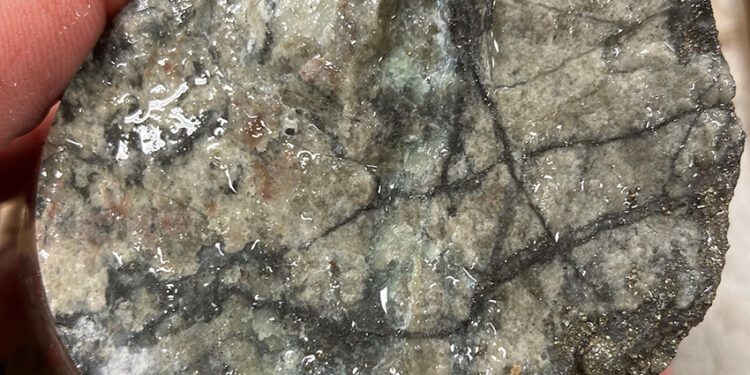Revival Gold Inc. (TSXV: RVG, OTCQX: RVLGF) has obtained promising results from the final drill hole completed in the Joss target area as part of this year’s exploration programme at the Beartrack-Arnett Gold Project located in Idaho, USA.
Drilling returned broad, high-grade intercepts which underscore the underground mining potential of this one-kilometre-long zone at Beartrack-Arnett.
Highlights
- 4.34 g/t gold over 110.6 meters including 12 g/t gold over 13.7m and 8.8 g/t gold over 11.8m in BT21-240D;
- BT21-240D intersected the Panther Creek Shear Zone (PCSZ) in the Joss target area at about 430m downhole (about 350m depth) mid-way along strike between drill holes BT21-237D and BT21-238D; and,
- Further analysis and interpretation are pending.
“This is a game-changing hole as it hosts the highest-grade gold intersections released to date from the Joss target area. With BT21-240D we are now beginning to see the full potential of the Beartrack-Arnett gold project,” said President and CEO, Hugh Agro.
“The high grades and substantial widths of mineralised structure encountered in BT21-240D reinforce our enthusiasm for the project’s underground potential and the possibility of it being developed into a highly profitable and long-life mining operation.
“We have had a very high success rate drilling in the PCSZ along more than five km of strike and we look forward to the resumption of drilling at Joss in the new year.”
Five holes were drilled in the Joss target area in 2021. Holes BT21-237D, BT21-238D and BT21-240D all intersected mineralization within the PCSZ. Holes BT21-236D and BT21-239DB were abandoned before intersecting the PCSZ in post-mineralization Tertiary rocks due to difficult drilling conditions.
However, drill hole BT21-239DB intersected fracture-controlled sericite alteration in metasediments of the Yellowjacket Formation, the host rock for mineralization in the Joss area.
Geochemical analysis confirmed the presence of weakly anomalous gold and arsenic values before the hole encountered an unexpected post-mineral fault that may have displaced the continuation of Joss mineralization in this area.
While the direction and amount of displacement is unknown at this time, this result suggests that mineralization may extend south along strike beyond current limits of drilling.
The PCSZ is the main structure which hosted mineralization exploited by the previous Beartrack mining operation and, as such, Joss is close to existing infrastructure including powerlines, roads, and other site facilities.
The Joss Target
Mineralization was discovered in the Joss area in 1991 by FMC Gold Company. Eight shallow reverse circulation holes were drilled that year, confirming the presence of mineralization with hole L007 intersecting 1.52 g/t gold over 30.5m beginning at 50m down hole depth, including 4.6 g/t gold over 3.0m.
Since 1997, 21 core holes totaling 8,420m have been completed over more than one km of strike in the Joss area. All 18 holes that intersected the PCSZ encountered mineralization. Those that did not intersect the PCSZ had been abandoned prior to reaching the target.
Drill holes that reached the target structure at Joss intersected broad intervals of lower-grade mineralized ranging from 2-4 g/t gold containing narrower, higher-grade intervals with grades ranging from 4 -11 g/t gold over true widths of one to five metres. Higher-grade mineralization extends northward from Joss into the South Pit area and mineralization is open to the south. Mineralization at Joss has been drilled to about 500 meters depth and, like mineralization elsewhere at Beartrack, is open at depth.
Over the past year, Revival Gold and the company’s engineering consultants have been evaluating the potential for narrow vein and bulk underground mining and milling at Beartrack-Arnett. Potential higher-grade, underground material in the Joss and South Pit areas offers the opportunity to supplement lower-grade, open pit mill material in any potential mine plan that might be developed for the site.
Underground development concepts under strategic review include conventional ramp-access supporting mechanized mining with truck haulage and long hole open stoping mining methods. The narrower, higher-grade zones could potentially support mining rates in the range of 1,000 tonnes/day to 2,000 tonnes/day, while the lower-grade, bulk mining areas could potentially support mining rates in the range of 2,000 tonnes/day to 4,000 tonnes/day.
The sub-vertical orientation of the mineralized zone and continuity along strike are favourable attributes for underground productivity. Geotechnical logging of the diamond drill core is assisting with evaluating rock stability design considerations.
For further information please visit: https://revival-gold.com/











